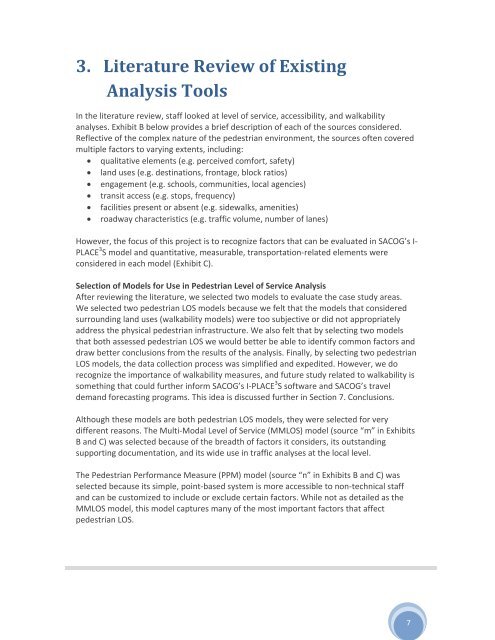Application of New Pedestrian Level of Service Measures - sacog
Application of New Pedestrian Level of Service Measures - sacog
Application of New Pedestrian Level of Service Measures - sacog
Create successful ePaper yourself
Turn your PDF publications into a flip-book with our unique Google optimized e-Paper software.
3. Literature Review <strong>of</strong> Existing<br />
Analysis Tools<br />
In the literature review, staff looked at level <strong>of</strong> service, accessibility, and walkability<br />
analyses. Exhibit B below provides a brief description <strong>of</strong> each <strong>of</strong> the sources considered.<br />
Reflective <strong>of</strong> the complex nature <strong>of</strong> the pedestrian environment, the sources <strong>of</strong>ten covered<br />
multiple factors to varying extents, including:<br />
qualitative elements (e.g. perceived comfort, safety)<br />
land uses (e.g. destinations, frontage, block ratios)<br />
engagement (e.g. schools, communities, local agencies)<br />
transit access (e.g. stops, frequency)<br />
facilities present or absent (e.g. sidewalks, amenities)<br />
roadway characteristics (e.g. traffic volume, number <strong>of</strong> lanes)<br />
However, the focus <strong>of</strong> this project is to recognize factors that can be evaluated in SACOG’s I‐<br />
PLACE 3 S model and quantitative, measurable, transportation‐related elements were<br />
considered in each model (Exhibit C).<br />
Selection <strong>of</strong> Models for Use in <strong>Pedestrian</strong> <strong>Level</strong> <strong>of</strong> <strong>Service</strong> Analysis<br />
After reviewing the literature, we selected two models to evaluate the case study areas.<br />
We selected two pedestrian LOS models because we felt that the models that considered<br />
surrounding land uses (walkability models) were too subjective or did not appropriately<br />
address the physical pedestrian infrastructure. We also felt that by selecting two models<br />
that both assessed pedestrian LOS we would better be able to identify common factors and<br />
draw better conclusions from the results <strong>of</strong> the analysis. Finally, by selecting two pedestrian<br />
LOS models, the data collection process was simplified and expedited. However, we do<br />
recognize the importance <strong>of</strong> walkability measures, and future study related to walkability is<br />
something that could further inform SACOG’s I‐PLACE 3 S s<strong>of</strong>tware and SACOG’s travel<br />
demand forecasting programs. This idea is discussed further in Section 7. Conclusions.<br />
Although these models are both pedestrian LOS models, they were selected for very<br />
different reasons. The Multi‐Modal <strong>Level</strong> <strong>of</strong> <strong>Service</strong> (MMLOS) model (source “m” in Exhibits<br />
B and C) was selected because <strong>of</strong> the breadth <strong>of</strong> factors it considers, its outstanding<br />
supporting documentation, and its wide use in traffic analyses at the local level.<br />
The <strong>Pedestrian</strong> Performance Measure (PPM) model (source “n” in Exhibits B and C) was<br />
selected because its simple, point‐based system is more accessible to non‐technical staff<br />
and can be customized to include or exclude certain factors. While not as detailed as the<br />
MMLOS model, this model captures many <strong>of</strong> the most important factors that affect<br />
pedestrian LOS.<br />
7
















